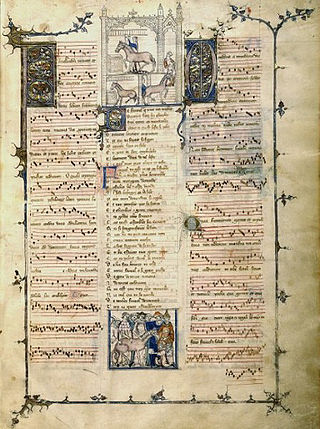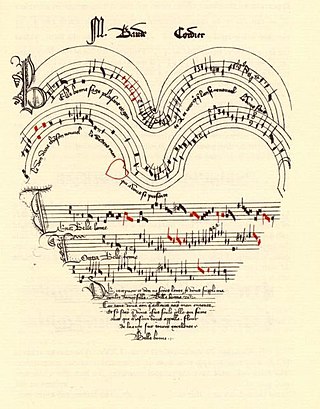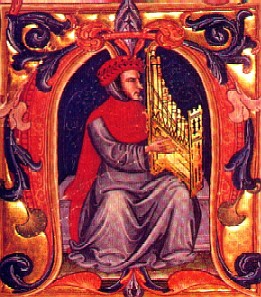Related Research Articles

Johannes Ockeghem was a Franco-Flemish composer and singer of early Renaissance music. Ockeghem was a significant European composer in the period between Guillaume Du Fay and Josquin des Prez, and he was—with his colleague Antoine Busnois—a prominent European composer in the second half of the 15th century. He was an important proponent of the early Franco-Flemish School.
Johannes Ciconia was an important Franco-Flemish composer and music theorist of trecento music during the late Medieval era. He was born in Liège, but worked most of his adult life in Italy, particularly in the service of the papal chapels in Rome and later and most importantly at Padua Cathedral.

Ars nova refers to a musical style which flourished in the Kingdom of France and its surroundings during the Late Middle Ages. More particularly, it refers to the period between the preparation of the Roman de Fauvel (1310s) and the death of composer Guillaume de Machaut in 1377. The term is sometimes used more generally to refer to all European polyphonic music of the fourteenth century. For instance, the term "Italian ars nova" is sometimes used to denote the music of Francesco Landini and his compatriots, although Trecento music is the more common term for the contemporary 14th-century music in Italy. The "ars" in "ars nova" can be read as "technique", or "style". The term was first used in two musical treatises, titled Ars novae musicae by Johannes de Muris, and a collection of writings attributed to Philippe de Vitry often simply called "Ars nova" today. Musicologist Johannes Wolf first applied to the term as description of an entire era in 1904.

Ars subtilior is a musical style characterized by rhythmic and notational complexity, centered on Paris, Avignon in southern France, and also in northern Spain at the end of the fourteenth century. The style also is found in the French Cypriot repertory. Often the term is used in contrast with ars nova, which applies to the musical style of the preceding period from about 1310 to about 1370; though some scholars prefer to consider ars subtilior a subcategory of the earlier style. Primary sources for ars subtilior are the Chantilly Codex, the Modena Codex, and the Turin Manuscript.

The Burgundian School was a group of composers active in the 15th century in what is now northern and eastern France, Belgium, and the Netherlands, centered on the court of the Dukes of Burgundy. The school inaugurated the music of Burgundy.
Solage, possibly Jean So(u)lage, was a French composer, and probably also a poet. He composed the most pieces in the Chantilly Codex, the principal source of music of the ars subtilior, the manneristic compositional school centered on Avignon at the end of the century.
Johannes Cesaris was a French composer of the late Medieval era and early Renaissance. He was one of the composers of the transitional style between the two epochs, and was active at the Burgundian court in the early 15th century.
France has a rich music history that was already prominent in Europe as far back as the 10th century. French music originated as a unified style in medieval times, focusing around the Notre-Dame school of composers. This group developed the motet, a specific musical composition. Notable in the high Middle Ages were the troubadours and trouvères soon began touring France, composing and performing many original songs. The styles of ars nova and ars subtilior sprung up in the 14th century, both of which focused on secular songs. As Europe moved into the Renaissance age, the music of France evolved in sophistication. The popularity of French music in the rest of Europe declined slightly, yet the popular chanson and the old motet were further developed during this time. The epicenter of French music moved from Paris to Burgundy, as it followed the Burgundian School of composers. During the Baroque period, music was simplified and restricted due to Calvinist influence. The air de cour then became the primary style of French music, as it was secular and preferred by the royal court.

Baude Cordier was a French composer in the ars subtilior style of late medieval music. Virtually nothing is known of Cordier's life, aside from an inscription on one of his works which indicates he was born in Rheims and had a Master of Arts. Some scholars identify him with Baude Fresnel, a harpist and organist in the court of Philip the Bold, though other scholars have rejected this.

The Trecento was a period of vigorous activity in Italy in the arts, including painting, architecture, literature, and music. The music of the Trecento paralleled the achievements in the other arts in many ways, for example, in pioneering new forms of expression, especially in secular song in the vernacular language, Italian. In these regards, the music of the Trecento may seem more to be a Renaissance phenomenon; however, the predominant musical language was more closely related to that of the late Middle Ages, and musicologists generally classify the Trecento as the end of the medieval era. Trecento means "three hundred" in Italian but is usually used to refer to the 1300s. However, the greatest flowering of music in the Trecento happened late in the century, and the period is usually extended to include music up to around 1420.

Antonio "Zacara" da Teramo was an Italian composer, singer, and papal secretary of the late Trecento and early 15th century. He was one of the most active Italian composers around 1400, and his style bridged the periods of the Trecento, ars subtilior, and beginnings of the musical Renaissance.
Reginaldus Libert was a French composer of the early Renaissance. He was a minor member of the Burgundian School, a contemporary of Guillaume Dufay, and one of the first to use fauxbourdon in a mass setting.
Philippus de Caserta, was a medieval music theorist and composer associated with the style known as ars subtilior.
Conradus de Pistoria was an Italian composer of the late medieval era and early Renaissance, active in Florence and elsewhere in northern Italy. He is listed in the standard histories of music for the period, including the New Oxford History of Music: Ars Nova and the Renaissance, 1300–1540, and the New Grove. Conradus was an Italian representative of the manneristic school of composers known as the ars subtilior, closely associated with the courts of the schismatic popes during the period of the Avignon Papacy.
Matheus de Sancto Johanne, also known as Mayshuet, was a French composer of the late Medieval era. Active both in France and England, he was one of the representatives of the complex, manneristic musical style known as the ars subtilior which flourished around the court of the Avignon Papacy during the Great Schism.
Jehan Vaillant was a French composer and music theorist. He is named immediately after Guillaume de Machaut by the Règles de la seconde rhétorique, which describes him as a "master … who had a school of music in Paris". Besides five pieces of music surviving to his name, he was also the author of a treatise on tuning. With Grimace and F. Andrieu and P. des Molins, Vaillant was part of the post-Machaut generation whose music shows few distinctly ars subtilior features, leading scholars to recognize Vaillant's work as closer to the ars nova style of Machaut.

Johannes SymonisHasprois was a French composer originally from Arras. Four of his works of music survive in four different manuscripts, and he may also have written a treatise on astrology.
Jo[hannes] Susay or Jehan Suzay was a French composer of the Middle Ages. He is the composer of three ballades in the ars subtilior style, all found in the Chantilly Codex: A l'albre sec, Prophilias, un des nobles, and Pictagoras, Jabol et Orpheus. The last ballade is also found in the Boverio Codex, Turin T.III.2, with the more accurate incipit "Pytagoras, Jobal, et Orpheus". A a three-voice Gloria "in fauxbourdon-like style" found in the Apt codex is also attributed to Susay.
P. des Molins, probably Pierre des Molins, was a French composer-poet in the ars nova style of late medieval music. His two surviving compositions – the ballade De ce que fol pensé and rondeau Amis, tout dous vis – were tremendously popular as they are among the most transmitted pieces of fourteenth-century music. The ballade is found in 12 medieval manuscript sources and featured in a c. 1420 tapestry; the rondeau is found in 8 sources and referenced by the Italian poet Simone de' Prodenzani. Along with Grimace, Jehan Vaillant and F. Andrieu, Molins was one of the post-Guillaume de Machaut generation whose music shows few distinctly ars subtilior features, leading scholars to recognize Molins's work as closer to the ars nova style of Machaut.
References
- ↑ Wright, "Tapissier, Johannes", Grove.
- ↑ Reese, p. 13.
- ↑ Wright, "Burgundy", Grove
- ↑ Wright, "Tapissier, Johannes", Grove
- ↑ Reese, p. 12.
- ↑ Fétis, François-Joseph (1866). "Aaron—Bohrer" (PDF). Biographie universelle des musiciens (in French). Vol. 1 (2nd ed.). Paris: Firmin Didot Frères. p. 417 – via IMSLP.